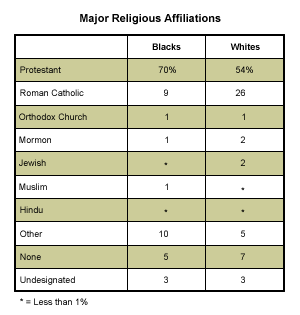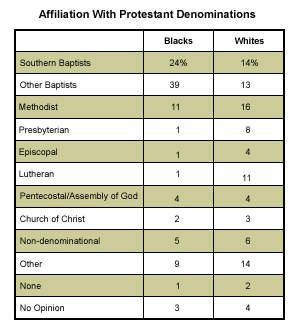This is the second of a two-part article on segregation among U.S. churches. This part examines the denominations and styles of worship among whites and blacks, and discusses how and why contact between black congregations and white congregations should be encouraged.
Last week, we addressed the simple explanation that blacks and whites still in many cases live in separate communities and go to church near where they live (see Related Items). But there is another factor contributing to the high degree of segregation between "black" and "white" congregations: Dominant religious denominations vary between blacks and whites. As the table below (based on ║┌┴¤═° surveys from the last decade of a total of 25,000 adults nationwide) shows, 70% of blacks and 54% of whites give their religious preference as Protestant. Denominationally, blacks are overwhelmingly Baptist, while the preferences of whites are spread across a spectrum of denominations and traditions.
The graph below lists the major religious affiliations of blacks and whites.

The following graph compares the Protestant denomination affiliations among blacks and whites.

Some observers have commented on the vitality of worship in black churches as compared to white churches. In a special ║┌┴¤═° survey of black pastors and senior lay leaders, undertaken for the ITC/Faith Factor Project 2000*, two-thirds of survey respondents (68%) said that the statement "Your congregation is spiritual, vital and alive" applies to their congregation "very well." Virtually the same proportion (66%) answered the same way to the statement, "Your congregation helps members deepen their relationship with God."
Contact Between Black Churches and White Churches
To what extent, and in what other ways, do black churches and white churches around the nation connect with each other, if not in regular Sunday services? This same survey shows 60% of black pastors and senior lay leaders reporting involvement of their churches in ecumenical or interfaith activities with white congregations.
It seems that both black and white religious communities could see a great deal of mutual benefit from greater and more direct contact with one another. With the nation's 350,000 churches reaching an estimated 60% of the population each week, it's reasonable to presume that suburban churches can have an incredible impact by establishing partnerships with city churches -- many of which serve black communities -- to help them struggle out of poverty and deal with attendant health and social issues. Conversely, the possible religious influence of African-American churches and congregations on their white counterparts could be energizing in light of the high level of religiosity among the black population, and the greater salience of the church in black communities (see "Black Churches: Has Their Role Changed?" in Related Items).
Key Points
Given the logistical, ideological and political reasons why churches remain among the most segregated of social institutions, one can only speculate as to whether a greater degree of integration will be achieved in the 21st century. One thing we know for certain is that black churches and white churches, as well as the religious communities of countless other cultural and ethnic groups that live in this country, have much to learn from one another.
*Findings are based on telephone interviews with 1,863 pastors and senior lay leaders of black or predominantly black churches in the United States. Interviews were conducted between Feb. 22 and May 11, 2000. For results based on the total sample, one can say with 95% confidence that the margin of sampling error is ±2.3%.
